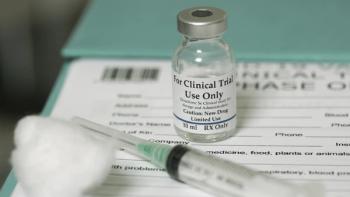
- Optometry Times September 2019
- Volume 11
- Issue 9
Consider IOP fluctuations when diagnosing glaucoma
The task of diagnosing normal-tension
To me, the most challenging aspect of making this diagnosis is separating it from two significant differential diagnoses: primary open-angle
As far as its distinction from “high-tension”
Previously by Dr. Casella: Maintain open communication with primary-care physicians
Taking action
Simply put, there is a great deal of time between the hours of 5 p.m. and 9 a.m. for intraocular pressure (IOP) to spike, and I am sure that I am missing a number of my patients’ highest IOPs.
If I never record an IOP outside of so-called “normal” ranges on a glaucoma patient prior to the initiation of treatment-and subsequently make a diagnosis of normal-tension
Although this really does not affect my plan-which is typically to initiate treatment with a prostaglandin analog-the semantics of the whole thing bother me.
On the other hand, all ODs learned in optometry school that
If I am unsure, then I may decide to obtain a few sequential visual studies and optical coherence tomography (OCT) studies before initiating treatment.
Related: Blog: 4 uses for OCT in OD practices Patient profile
Patient history can also be useful in such a situation. Careful questioning may elicit a history of, say, hemodynamic crisis, long-term steroid use, or other aspects of a patient’s life, which may have led to his optic nerves’ appearance.
In other words, did something happen in the past that is done happening? This is in an attempt to have a degree of specificity (not treating those patients who do not require treatment) in the arena of
All of this can be difficult to keep mind of during the course of a busy day-something all ODs deal with.
Related: Consider the whole patient when treating glaucoma
Fortunately, as far as treatment is concerned, ODs have access to landmark studies such as the Collaborative Normal-Tension Glaucoma Study (CNTGS), to which they may subscribe to guide their treatment approach.1
Out of this study came the notion that a 30-percent reduction in IOP leads to a lesser chance of progression of normal-tension
However, for those patients in whom baseline IOPs are on the low end to begin with (12 or 14 mm Hg), there really is not much room for a decrease at all, and a 20 or 30 percent reduction may be all that is attainable.
Not many
Related: Why documenting target IOP helps ODs
Low-teens normal-tension glaucoma
However, a study was recently published in British Journal of Ophthalmology that led to intriguing factors to consider with so-called “low-teens normal-tension glaucoma.”2
This retrospective cohort study included 102 eyes of 102 normal-tension glaucoma patients with baseline (pretreatment) IOPs of ≤12 mm Hg.
All patients had been followed for a period of at least five years. The patients were divided into so-called “progressor” and “non-progressor” groups based on their visual field studies over time as well as changes to their optic nerves and retinal nerve fiber layers.
Diurnal IOP measurements and 24-hour blood pressure measurements were compared as well. Of the entire cohort, 35.3 percent were determined to be “progressors.”
Related:
Of these patients, fluctuations in diastolic blood pressure, IOP fluctuations, and the presence of optic disc hemorrhages were significant risk factors for the presence of progression.
Three take-home points pulled from this study include:
• Glaucoma patients (and all patients, for that matter) should be receiving routine physicals-both in light of searching for systemic variables with respect to glaucoma and in light of good overall health and well-being.
• Lowering IOP comes before nothing with respect to glaucoma treatment, but squishing the diurnal IOP curve is important as well. A good way to ensure this and tailor therapy accordingly is to check IOP at different times of the day. I do not typically perform serial tonometry, but I instead check IOP at different parts of the day over an extended period of time-which is not judgment on serial tonometry.
• Taking a quick look at optic nerves at an IOP check through an undilated pupil with a precorneal lens is a great way to check for the presence of an optic disc hemorrhage, which may be an indicator of progression.
Read more by Dr. Casella
References:
1. Bron A. Ocular hypertension and glaucoma: the contribution of large studies to daily practice. J Fr Ophtalmol. 2002 Jun;25(6):641-54.
2. Baek SU, Ha A, Kim DW, Jeoung JW, Park KH, Kim YK. Risk factors for disease progression in low-teens normal-tension glaucoma. Br J Ophthalmol. 2019 May 4. doi: 10.1136/bjophthalmol-2018-313375.
Articles in this issue
about 6 years ago
How to incorporate nutrition into dry eye practiceabout 6 years ago
As seen on TV: Doing harm, not help, to the ocular surfaceabout 6 years ago
Overlooked causes of dry eyeabout 6 years ago
Use aesthetics to treat lid and periorbital conditionsabout 6 years ago
How pain gates affect dry eye and chronic painover 6 years ago
How inflammation may play a role in retinal diseaseover 6 years ago
How implementing a hiring process netted a great staffover 6 years ago
Follow new norm of identifying and treating patient pitfallsover 6 years ago
Ensure patients know follow-up visits may be coveredNewsletter
Want more insights like this? Subscribe to Optometry Times and get clinical pearls and practice tips delivered straight to your inbox.













































.png)


